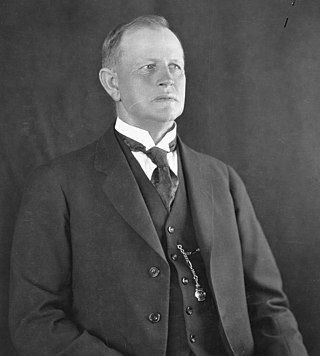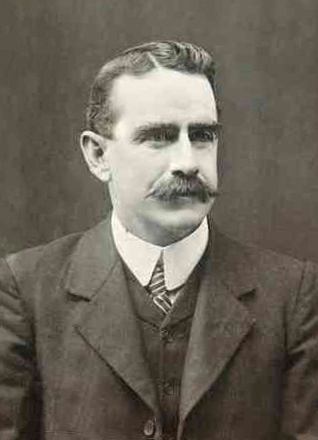Related Research Articles

Crawford Vaughan was an Australian politician, and the Premier of South Australia from 1915 to 1917. He was a member of the South Australian House of Assembly from 1905 to 1918, representing Torrens (1905–1915) and Sturt (1915–1918). Elected for the United Labor Party, he served as Treasurer in the Verran government, succeeded Verran as Labor leader in 1913, and was elected Premier after the Labor victory at the 1915 state election.
The Victorian Farmers' Union (VFU) was an association of farmers and primary producers formed in 1914 in the Australian state of Victoria. Although initially formed as an "absolutely non-political" entity, the VFU became a political party in 1916, and nominated candidates for the 1917 state election and subsequent elections. In later years it used the names Victorian Country Party, then United Country Party and is now the National Party of Australia – Victoria. At the 1917 election, because the support for the VFU was concentrated in rural seats, it won four of the 11 seats in the Victorian Legislative Assembly it contested, gaining about 6% of the vote state-wide. In 1918 it also won its first seat in the federal parliament, after preferential voting was introduced. At the 1920 state election the VFU vote increased to 8% and the number of seats to 13, giving the VFU the balance of power in the state Legislative Assembly.

George Edwin Yates, often referred to as Gunner Yates, was an Australian politician. He was an Australian Labor Party member of the Australian House of Representatives from 1914 to 1919 and from 1922 to 1931, representing the electorate of Adelaide.

The Hon Andrew Alexander Kirkpatrick was an Australian politician, representing the South Australian Branch of the Australian Labor Party. He was a member of the South Australian Legislative Council from 1891 to 1897 and 1900 to 1909, a member of the South Australian House of Assembly from 1915 to 1918, and again a member of the Legislative Council from 1918 to 1928. He was the state Agent General in London from 1909 to 1914. Kirkpatrick was state Labor leader from 1917 to 1918, when the party split nationally over Billy Hughes' stance on conscription.
The Liberal Union was a political party in South Australia resulting from a merger between the Liberal and Democratic Union (LDU) and the two independent conservative parties, the Australasian National League and the Farmers and Producers Political Union (FPPU) as a response to Labor successes culminating in South Australia's first majority government at the 1910 election.

State elections were held in South Australia on 6 April 1918. All 46 seats in the South Australian House of Assembly were up for election. The incumbent Liberal Union government led by Premier of South Australia Archibald Peake defeated the opposition Australian Labor Party led by Leader of the Opposition Andrew Kirkpatrick. Each district elected multiple members, with voters casting multiple votes.

William Humphrey Harvey was an Australian politician. He was a member of the South Australian Legislative Council from 1915 to 1935. He served as Minister for Education, Mines and Agriculture from 1918 to 1920.

John Howard Vaughan CBE, known as Howard, was an Australian politician. He was a member of the South Australian Legislative Council from 1912 to 1918, representing the United Labor Party (1912-1917) and the National Party (1917-1918). He served as the Attorney-General of South Australia from 1915 to 1917.

Clarence Goode was a farmer and politician in South Australia. Descendants pronounce the family name to rhyme with "wood".

Frederick Samuel Wallis was a trade unionist and politician in the state of South Australia.

James Phillips Wilson was a politician in South Australia.

William Joseph Denny was an Australian journalist, lawyer, politician and decorated soldier who held the South Australian House of Assembly seats of West Adelaide from 1900 to 1902 and then Adelaide from 1902 to 1905 and again from 1906 to 1933. After an unsuccessful candidacy as a United Labor Party (ULP) member in 1899, he was elected as an "independent liberal" in a by-election in 1900. He was re-elected in 1902, but defeated in 1905. The following year, he was elected as a ULP candidate, and retained his seat for that party until 1931. Along with the rest of the cabinet, he was ejected from the Australian Labor Party in 1931, and was a member of the Parliamentary Labor Party until his electoral defeat at the hands of a Lang Labor Party candidate in 1933.
The Country Party was a political party in South Australia in the first part of the 20th century. It was formed out of the Farmers and Settlers Association in September 1917 to represent the association's interests in parliament. The party endorsed seven candidates in the 1918 election, with two elected. In the early years, their representatives were usually identified as Farmers and Settlers' Association representatives or as the parliamentary wing of the Farmers and Settlers' Association, but referred to in some sources as Country Party, Independent Country Party or independent members. The Country Party name was formally adopted after the 1921 election.

Frederick William Coneybeer was an Australian politician. He was a member of the South Australian House of Assembly from 1893 to 1921 and from 1924 to 1930, representing the electorates of East Torrens and Torrens (1902–1915).
This is a list of candidates of the 1918 South Australian state election.

Harry Jackson was an Australian politician who represented the South Australian House of Assembly seats of Stanley from 1906 to 1915 and Port Pirie from 1915 to 1918. He represented the United Labor Party until the 1917 Labor split, when he was expelled and joined the splinter National Party. He served as Speaker of the South Australian House of Assembly from 1911 to 1912.
This is a list of members of the South Australian House of Assembly from 1915 to 1918, as elected at the 1915 state election:

William David Ponder was an Australian politician who represented the South Australian House of Assembly multi-member seats of Adelaide from 1905 to 1915 and North Adelaide from 1915 to 1921. He represented the United Labor Party until the 1917 Labor split, when he joined the National Party.
Maurice William Parish was an Australian politician who represented the South Australian House of Assembly multi-member seat of Murray from 1915 to 1918. He was elected at as a United Labor Party member, left the party to join the National Party in the 1917 Labor split, and became an independent in 1918.
Richard Alfred O'Connor was an Australian politician. He was a Liberal Union member of the South Australian House of Assembly from 1915 to 1921, representing the multi-member seat of Albert.
References
- ↑ "THE LABOR SPLIT". The Advertiser . Adelaide: National Library of Australia. 13 February 1917. p. 7. Retrieved 17 January 2015.
- ↑ "STATE POLITICS". The Register . Adelaide: National Library of Australia. 12 April 1917. p. 7. Retrieved 17 January 2015.
- ↑ "NATIONAL PARTY". Daily Herald . Adelaide: National Library of Australia. 28 June 1917. p. 4. Retrieved 17 January 2015.
- ↑ ""SUDDEN DEATH."". The Register . Adelaide: National Library of Australia. 13 July 1917. p. 7. Retrieved 17 January 2015.
- ↑ "Union of Parties". The Advertiser. Adelaide. 30 November 1917. Retrieved 28 November 2019.
- ↑ "ORGANIC UNION". Daily Herald . Adelaide: National Library of Australia. 29 November 1917. p. 4. Retrieved 17 January 2015.
- ↑ "STATE POLITICS". The Register . Adelaide: National Library of Australia. 7 February 1918. p. 5. Retrieved 17 January 2015.
- ↑ "STATE POLITICS". The Advertiser . Adelaide: National Library of Australia. 11 February 1932. p. 12. Retrieved 17 January 2015.
- ↑ "THE COMING ELECTIONS". The Advertiser . Adelaide: National Library of Australia. 21 January 1921. p. 7. Retrieved 14 May 2015.
- ↑ "HOPE ABANDONED". The Mail . Adelaide: National Library of Australia. 12 March 1921. p. 2. Retrieved 14 May 2015.
- ↑ "THE PROGRESSIVE COUNTRY PARTY AND CANDIDATES". The Advertiser . Adelaide: National Library of Australia. 5 March 1921. p. 13. Retrieved 14 May 2015.
- ↑ "STATE POLITICS". The Advertiser . Adelaide: National Library of Australia. 11 February 1932. p. 12. Retrieved 17 January 2015.
- ↑ "DECISIVE LIBERAL VICTORY". The Register . Adelaide: National Library of Australia. 11 April 1921. p. 7. Retrieved 14 May 2015.
- ↑ "NEWS OF THE DAY". The Register . Adelaide: National Library of Australia. 14 July 1921. p. 6. Retrieved 17 January 2015.
- ↑ "TELEGRAMS". The Border Watch . Mount Gambier, SA: National Library of Australia. 16 October 1923. p. 3. Retrieved 17 January 2015.
- ↑ "NEWS OF THE DAY". The Register . Adelaide: National Library of Australia. 16 October 1923. p. 8. Retrieved 17 January 2015.